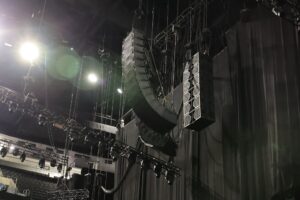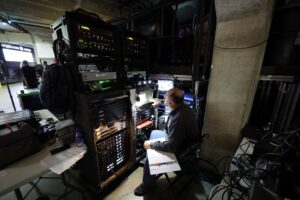Editor’s Note: This story originally was published on Jan. 22 and has since been updated as or Jan. 23, 2024
The Grammy Awards telecast, the most recent of which was broadcast on CBS on Feb. 4, is intended to highlight what’s new and unexpected in music. It’s also meant to showcase the unique stylistic signatures that nominees and winners like Dua Lipa, Olivia Rodrigo, Taylor Swift and Billie Eilish (and her sonically adventurous brother/producer, Finneas) can create.
However, the show itself, like every live-event production, seeks predictability and certainty over everything else. How they achieve that, year-after-year for the last 66 years, is a function of making incremental tweaks to its sound, video, lighting, and staging year-to-year, then rehearsing the heck out of them, looking for vulnerabilities and unforeseen trap doors before the curtain goes up on what’s come to be known as Music’s Biggest Night.
This year’s Grammy Awards production had 14 performances, about a third fewer than in recent years. This was to accommodate a longer-than-usual In Memoriam segment (for obvious reasons, underscoring just how old rock & roll is now) and more and extended prerecorded video artist and song introductions.
These changes came in the wake of other refinements and adjustments, most in pursuit of keeping the show to its 3.5-hour slot. The most radical of those came over a decade ago when the stage at the Crypto.com Arena (then known as the Staples Center) was bifurcated: as one artist performed before the 22,000 in the bowl, the next act was readying on the other side of the stage, which was covered by a drop curtain; center stage was kept open as the runway for presenters to reach the stage and winners to depart it. That staging adaptation continues today, helping keep the show moving (along with walk-off music that steadily increases in volume occasionally needed to curtail windy acceptance speeches). This year’s edition saw come other changes in the show’s production.
Big Sound

A hang of Cohesion CO12 system PA. Photograph courtesy of the Recording Academy/Getty Images © 2024 by Kevin Winter
Perhaps the biggest change was the switch to a new PA system, this one Cohesion CO12 system, which replaced the JBL VerTec and later VTX PAs the show had used for much of the last two decades. What didn’t change was ATK Audiotek, which was acquired by Clair last year, as the audio systems provider and manager for the show. While that may be coincidental, those show veterans running the new system were happy with its performance.
“I like the Cohesion prediction software — having the ability to see how the whole system is going to interact is nice,” says Jeff Peterson, FOH production mixer for ATK Audiotek and a multi-year veteran of the show. He says he especially looked forward to hearing the CP 218 II+ subwoofer performance at a time when music — and live events in general — place much more emphasis on low-frequency response. “Previously, we used non-powered subs fed from amplifiers on the ground. Since long speaker-cable [runs] hurts the punch and impact of subs, I look forward to having powered subs that don’t have that issue.”
The show’s PA comprised 56 CO12 (24x120deg) in four hangs of 14 each; another 32 CO10 boxes flown in four hangs of eight each for back-of-house delays, and 36 CO8 boxes in six hangs of six each for 300-level delays. These were powered by 63 Lab Gruppen PLM 20k44 4-channel amplifiers with Lake processing built in. The subwoofers are self-powered using a proprietary Clair module.
PA choice has implications for the production’s visuals, as well: high output and small form factors results in systems that enable better sightlines for audience members and less obstruction for cameras.
Up Close & Personal Sound
Another audio trick introduced last year saw the awards stage surrounded by 75 cocktail tables for seating of nominees and other VIPs. There, ATK deployed 150 low-profile K-array Tornado-KT2 two-inch point-source drivers, two per table, powered by Powersoft K10 amps.
The Tornados were used to provide near-field dialog from the stage and other sources to those seats, with the lower boxes of the main PA hangs muted during speeches, presentations, etc. This was done to avoid blasting those tables with concert-level sound for speakers’ voices, but with those same PA boxes ready to deliver the next song to the industry’s one-percenters.
I’ve Seen You Before

Steve Vaughn, RF technician, Soundtronics Wireless, adjusts wireless system at the Grammys. Photograph courtesy of the Recording Academy/Getty Images © 2024 by Kevin Winter.
Another way that the Grammy Awards keep uncertainty at bay is by relying on an extremely consistent crew to manage its AVL. For instance, Michael Abbott, the audio producer for the show, has been at it for 35 years, more than half the history of the show itself. John Harris, who co-mixes the broadcast music mixes of the show with Eric Schilling from the Music Mix Mobile truck, has been on this production for 20-plus years.
Abbott says the big challenge of the show in general is, “Getting everyone to not just coordinate but collaborate, to get the outcome everyone wants.”
If there was one moment that illustrated that challenge, it was last year’s “50 Years of Hip-Hop” salute, where Abbott recalled 55 wireless microphones were deployed in what turned out to be an ever-changing series of rappers and vocalists. It was, he says, his biggest curve ball in his time at the Grammys and the lesson for any event production is, he emphasizes, however much headroom you build in for anything, build in some more — time, people, patience.
Do You Hear What I Hear?
Monitors for any event, whether a music performance or a presentation, are critical. Michael Parker, piloting a Digico SD7 as one half of the two monitor positions at the show — one for each half of the split stage — says in his 23 years of mixing backstage the most important thing is paying attention. It’s not always easy to do on a long show, especially after days of intense rehearsals for multiple artists.
“You always have a finite number of channels available and you always may have to cross-pollinate them,” he says, recalling that same hip-hop extravaganza Abbott had mentioned. “Stay focused on what’s happening on stage and stay connected to everyone on the team.”
Look Ma, No Wires
RF manager Steve Vaughn says music shows have their own specific concerns, such as when vocal and instrument transmitters worn by the same person are placed too closely together, positioning largely dictated by stage costumes. “RF bleed can happen, because those IEM transmitters don’t reject much,” he explains. “If it’s anywhere near the [vocal transmitter’s] range, it’ll accept those frequencies, too. All you can do it try to keep them as separate as possible.”
He also had to keep the backline transmitters, working in the 944- to 960-MHz range, away from lower DECT frequencies, in the 901- to 928-MHz areas that robocams and certain lighting devices were using. “Even in the higher frequencies, it’s still a full-time job managing RF for a show like this,” he says. “And you have to be constantly aware of that those wireless systems might not get turned on until just before each performance. You don’t want anything to change in the meantime.”
The Grammy Awards are an experience, but at their heart they’re also a live-event production, one that AV professionals can always take a page from.
‘Click View Slideshow’ to see additional behind the scenes photos from the 66th annual Grammy Awards. All photos courtesy of the Recording Academy/Getty Images © 2024 by Kevin Winter
Dan Daley is a veteran freelance writer based in Nashville, Tenn. area.



